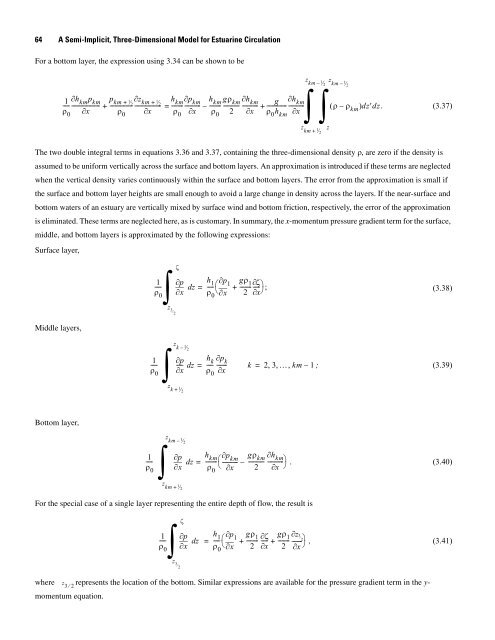A Semi-Implicit, Three-Dimensional Model for Estuarine ... - USGS
A Semi-Implicit, Three-Dimensional Model for Estuarine ... - USGS
A Semi-Implicit, Three-Dimensional Model for Estuarine ... - USGS
Create successful ePaper yourself
Turn your PDF publications into a flip-book with our unique Google optimized e-Paper software.
64 A <strong>Semi</strong>-<strong>Implicit</strong>, <strong>Three</strong>-<strong>Dimensional</strong> <strong>Model</strong> <strong>for</strong> <strong>Estuarine</strong> Circulation<br />
For a bottom layer, the expression using 3.34 can be shown to be<br />
1<br />
----ρ0<br />
hkmp ∂ km<br />
-------------------- +<br />
∂x<br />
pkm + 1⁄ 2 ----------------- zkm 1 ∂ + ⁄ 2 -------------------<br />
ρ 0<br />
∂x<br />
z<br />
km – 1⁄ 2<br />
∫<br />
z<br />
km – 1⁄ 2<br />
∫<br />
hkm -------ρ0<br />
p ∂ km hkm ----------- --------<br />
∂x<br />
ρ0 gρkm ------------<br />
2<br />
h ∂ km g<br />
– ----------- --------------<br />
∂x<br />
ρ0hkm h ∂ km<br />
= + ----------- ( ρ – ρ<br />
∂x<br />
km)dz′dz<br />
.<br />
(3.37)<br />
The two double integral terms in equations 3.36 and 3.37, containing the three-dimensional density ρ, are zero if the density is<br />
assumed to be uni<strong>for</strong>m vertically across the surface and bottom layers. An approximation is introduced if these terms are neglected<br />
when the vertical density varies continuously within the surface and bottom layers. The error from the approximation is small if<br />
the surface and bottom layer heights are small enough to avoid a large change in density across the layers. If the near-surface and<br />
bottom waters of an estuary are vertically mixed by surface wind and bottom friction, respectively, the error of the approximation<br />
is eliminated. These terms are neglected here, as is customary. In summary, the x-momentum pressure gradient term <strong>for</strong> the surface,<br />
middle, and bottom layers is approximated by the following expressions:<br />
Surface layer,<br />
Middle layers,<br />
Bottom layer,<br />
1<br />
---ρ0<br />
1<br />
---ρ0<br />
1<br />
---ρ0<br />
ζ<br />
∫<br />
z3 ⁄ 2<br />
∂p<br />
∂x<br />
z<br />
k – 1⁄ 2<br />
∫<br />
dz<br />
z<br />
km + 1⁄ 2<br />
h1 ∂p gρ<br />
----- 1 1<br />
-------ρ0<br />
∂x<br />
2<br />
ζ ∂<br />
= ⎛ + ----- ⎞ ;<br />
⎝ ∂x⎠<br />
(3.38)<br />
∂p<br />
hk ----- dz<br />
-----<br />
∂x<br />
ρ0 p ∂ k<br />
= ------- k = 2, 3, …, km – 1 ; (3.39)<br />
∂x<br />
z<br />
k + 1⁄ 2<br />
z<br />
km – 1⁄ 2<br />
∫<br />
∂p<br />
∂x<br />
z<br />
km + 1⁄ 2<br />
For the special case of a single layer representing the entire depth of flow, the result is<br />
1<br />
---ρ0<br />
ζ<br />
∫<br />
z3⁄ 2<br />
dz<br />
∂p<br />
∂x<br />
dz<br />
hkm ∂p<br />
gρ--------<br />
km km<br />
---------------------ρ0 ∂x<br />
2<br />
h ∂ km<br />
= ⎛ – ----------- ⎞ .<br />
(3.40)<br />
⎝ ∂x<br />
⎠<br />
z<br />
h1 ∂p gρ<br />
----- 1 1<br />
-------ρ0<br />
∂x<br />
2<br />
ζ ∂ gρ1 ----- --------<br />
∂x<br />
2<br />
z3 2<br />
⁄ ∂<br />
= ⎛ + + ------- ⎞ , (3.41)<br />
⎝ ∂x<br />
⎠<br />
where z 3 2<br />
⁄ represents the location of the bottom. Similar expressions are available <strong>for</strong> the pressure gradient term in the ymomentum<br />
equation.

















